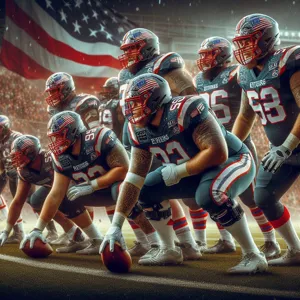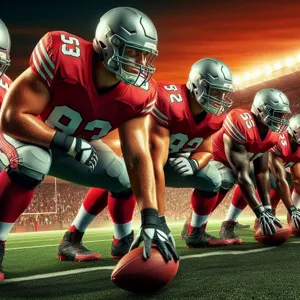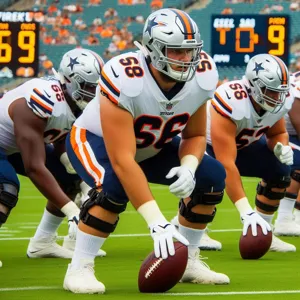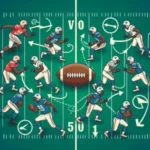In the world of American football, the spotlight often shines on star quarterbacks, agile wide receivers, and powerful running backs, but behind every successful play lies an unsung hero—the offensive line.
Often overshadowed by flashier positions, a strong offensive line is the backbone of any successful team, providing both protection and support that can make or break a game. These dedicated athletes are responsible for creating the time and space necessary for their teammates to thrive, standing as a formidable wall against opposing defenses. In this blog post, we will delve into the crucial role that a robust offensive line plays in shaping the dynamics of the game, exploring how their teamwork, strategy, and physical prowess directly influence a team’s performance and success on the field. Join us as we uncover the intricate mechanics of this vital unit and celebrate the often overlooked key to victory in American football.
1. Introduction to the Offensive Line’s Role in Football

In the high-octane world of American football, the spotlight often shines brightly on the skill players—the quarterbacks who throw dazzling passes, the running backs who dance through defenses, and the wide receivers who make gravity-defying catches. However, lurking behind these stars is a group of unsung heroes: the offensive line. Often overshadowed, this formidable unit serves as the backbone of any successful football team, providing the essential protection and support that allows offensive plays to develop.
The offensive line is typically composed of five players whose primary responsibility is to create a secure pocket for the quarterback and open up lanes for the running backs. These players are not only the first line of defense against aggressive defenders but also the architects of the offense’s strategy. They must possess a unique blend of size, strength, agility, and intelligence, as their role requires them to quickly diagnose defensive alignments, communicate effectively with one another, and execute their assignments with precision.
Every successful play begins with the offensive line’s ability to control the line of scrimmage. Their strength and cohesion can dictate the tempo of the game, allowing the offense to establish dominance and rhythm. A strong offensive line can mean the difference between a quarterback finding time to execute a perfect pass or being pressured into a costly mistake. Similarly, it can transform a mere run into a game-changing play that shifts the momentum.
In essence, the offensive line’s role goes far beyond mere blocking; it is a complex, dynamic interplay of strategy, teamwork, and execution that lays the foundation for a potent offense. Without a well-functioning offensive line, even the most talented skill players can struggle to make an impact. Understanding the critical role they play helps us appreciate the intricate ballet that is American football and highlights why the offensive line is truly essential for success on the gridiron.
2. Understanding Offensive Line Positions
Understanding offensive line positions is crucial for grasping the intricacies of American football. The offensive line consists of five key positions, each with distinct responsibilities that contribute to the overall success of the team.
1. **Left Tackle**: Often regarded as one of the most critical positions on the line, the left tackle protects the quarterback’s blind side. This player must be exceptionally agile and strong, as they face some of the opponent’s best pass-rushers. A left tackle’s ability to fend off defensive linemen can mean the difference between a clean pass and a devastating sack.
2. **Left Guard**: Positioned next to the left tackle, the left guard plays a vital role in both pass protection and run blocking. This player is often tasked with creating openings for running backs and providing support to the quarterback. A strong left guard can help establish a solid foundation for the offensive strategy.
3. **Center**: The center is the leader of the offensive line, responsible for snapping the ball to the quarterback and making pre-snap reads of the defense. This player must possess a deep understanding of the game, as they often call out blocking assignments and adjustments based on the defensive alignment. The center’s ability to communicate effectively can unify the line and enhance overall performance.
4. **Right Guard**: Similar to the left guard, the right guard works to protect the quarterback and create running lanes. However, they often face different defensive schemes, making adaptability crucial. A skilled right guard can significantly bolster the team’s offensive capabilities by effectively managing both run and pass plays.
5. **Right Tackle**: Completing the line, the right tackle has the dual responsibility of protecting the quarterback and enabling successful runs. This position often requires a blend of size and speed, as right tackles must handle both edge rushers and interior defenders. A reliable right tackle can help maintain offensive balance and provide crucial support during high-pressure moments.
Each of these positions plays a vital role in shaping the success of the offensive line. When well-coordinated, these players work in unison to create a formidable wall of protection, allowing quarterbacks ample time to survey the field and running backs the opportunity to break through defensive lines. Understanding the nuances of these positions is essential not only for fans and analysts but also for aspiring players looking to appreciate the art of the offensive line and its impact on the game.
3. The Keys to a Successful Offensive Line

The success of an offensive line in American football hinges on several critical factors that work in harmony to create a formidable unit on the field. Understanding these keys can illuminate why a strong offensive line is often considered the backbone of a successful team.
**1. Communication:** At the heart of any successful offensive line is a seamless line of communication. Linemen must be able to quickly and efficiently share information, whether it’s identifying defensive alignments or adjusting blocking schemes on the fly. A well-coordinated offensive line communicates through verbal cues, hand signals, and even eye contact, ensuring that each player is on the same page. This clarity is vital in preventing missteps that could lead to costly sacks or disrupted plays.
**2. Cohesion and Chemistry:** Offensive linemen operate as a unit, and their effectiveness largely depends on their ability to work together. Each player must understand their role within the scheme and how it interrelates to the responsibilities of their teammates. Developing this chemistry often takes time and experience playing alongside one another. teams that invest in building strong relationships among linemen tend to see improved performance on the field as they instinctively know how to react to each other’s movements and decisions.
**3. Technique and Fundamentals:** Sound technique is crucial for linemen to execute their plays effectively. This includes footwork, hand placement, and body positioning. Coaches emphasize the importance of mastering these fundamentals, as they enable players to maintain leverage and control against defenders. A lineman who consistently uses proper technique is less likely to be pushed back into the pocket or called for penalties, allowing the offense to function smoothly.
**4. Physical Conditioning:** The demands placed on offensive linemen are immense, requiring not just strength but also endurance and agility. A well-conditioned offensive line can sustain its level of play throughout the game, protecting the quarterback and creating running lanes. Regular strength training, flexibility exercises, and conditioning drills are essential components of a lineman’s training regimen, ensuring they can dominate their opponents in the trenches.
**5. Versatility:** In modern football, versatility is a prized trait for offensive linemen. Coaches appreciate players who can adapt to multiple positions along the line, whether it’s shifting from guard to tackle or vice-versa. This flexibility allows teams to respond to injuries or tactical shifts without compromising their overall effectiveness. Linemen who can confidently play various roles provide invaluable depth and stability to the offensive line.
In conclusion, the keys to a successful offensive line lie in communication, cohesion, technique, physical conditioning, and versatility. When these elements come together, they form a strong foundation that not only protects the quarterback but also paves the way for a dynamic and effective offense. A well-functioning offensive line can be the difference between a mediocre season and a championship run, underscoring its crucial role in the game of football.
4. How a Strong Offensive Line Protects the Quarterback
In American football, the offensive line is often referred to as the unsung heroes of the game, and for good reason. A strong offensive line is paramount in safeguarding the quarterback, allowing them the time and space necessary to execute plays effectively. The relationship between the offensive line and the quarterback is built on trust and communication, where each play begins with a well-coordinated effort to create a protective barrier against aggressive defenders.
When the offensive line is functioning at its best, it forms an impenetrable wall, blocking defensive players and ensuring that the quarterback has a clear pocket from which to survey the field. This is not merely a physical task; it requires keen awareness and the ability to anticipate the movements of both teammates and opponents. Each lineman has a specific role, whether it’s engaging directly with a defensive player, pulling to create additional protection, or creating running lanes for the backs. The success of these maneuvers can mean the difference between a successful pass and a devastating sack.
Moreover, a strong offensive line instills confidence in the quarterback. Knowing that they have reliable protection allows the quarterback to focus on reading defenses and making strategic decisions rather than worrying about imminent pressure. This mental security can lead to improved performance, allowing for better throws, quicker decision-making, and ultimately, more scoring opportunities.
A quarterback who feels secure in the pocket can take the necessary risks, throwing deep passes or attempting plays that may have otherwise been too perilous if they were under constant threat. The synergy between a skilled quarterback and a robust offensive line can elevate an entire team’s performance, often translating into wins. In essence, the offensive line is not just a protective shield; it is a fundamental component in enabling offensive creativity and success on the field.
5. Impact on the Running Game: Opening Up Running Lanes

In American football, the offensive line serves as the unsung heroes of the running game, wielding immense power in shaping the outcome of each play. A strong offensive line not only protects the quarterback but also opens up vital running lanes for the team’s ball carriers. When executed correctly, the synergy between the offensive line and running backs can lead to explosive gains, shifting the momentum of the game.
Picture a well-coordinated offensive line as a formidable wall, working in unison to create space and leverage against the defense. Their ability to drive defenders off the line of scrimmage is crucial for establishing a solid ground game. When an offensive line effectively utilizes techniques such as zone blocking or power blocking, they can manipulate defensive formations, displacing defenders and allowing running backs to find gaps to exploit.
The importance of communication cannot be overstated. The offensive linemen need to be in constant sync, anticipating defensive movements and adjusting their blocking schemes accordingly. A split-second miscommunication can lead to a broken play, resulting in a negative yardage or worse, a turnover. A cohesive line will often engage in pre-snap discussions, ensuring every member is aware of their assignments and the potential adjustments necessary based on the defense’s alignment.
Moreover, the presence of a dominant offensive line can alleviate pressure on the running backs, allowing them to focus on their vision and agility. With running lanes opened up, backs can showcase their speed and elusiveness, turning what could be modest gains into spectacular breakaway runs. The psychological impact is profound as well; knowing that their blockers are formidable can instill confidence in running backs, inspiring them to be more aggressive and decisive with their cuts.
In summary, a strong offensive line is essential for a successful running game. By opening up running lanes and providing the necessary protection and support, they play a pivotal role in not only advancing the ball but also setting the tone for the entire offense. As the backbone of any successful team, a dominant offensive line can make all the difference in the quest for victory on the gridiron.
6. The Importance of Chemistry and Communication
In American football, the strength of an offensive line extends far beyond physical size and skill; it hinges critically on the chemistry and communication among its players. Unlike other positions where individual prowess can shine, the offensive line operates as a cohesive unit, and its effectiveness is often determined by how well the players synchronize their movements and strategies on the field.
Chemistry among offensive linemen is built through countless hours of practice, where they learn each other’s tendencies, strengths, and weaknesses. When a lineman knows how his teammates react in various situations, it fosters a sense of trust that is invaluable during the chaos of a game. This trust allows them to make split-second decisions, adjust blocking schemes, and support each other in the face of aggressive defensive plays. It’s this unspoken understanding that can turn a good offensive line into a great one.
Communication is equally vital. Offensive linemen must convey information rapidly, especially in the heat of a game. They rely on a combination of verbal calls, non-verbal cues, and hand signals to ensure everyone is on the same page. Whether it’s signaling a change in blocking assignments or alerting teammates to an impending blitz, clear and concise communication can be the difference between a successful play and a disastrous one.
Moreover, the synergy between the center and the other linemen is paramount. The center acts as the brain of the offensive line, often making pre-snap adjustments based on the defensive alignment. If the center’s directives aren’t clearly communicated or if the other linemen fail to understand them, it can lead to confusion and missed assignments. This is particularly crucial during high-pressure moments when the stakes are highest.
In summary, the importance of chemistry and communication cannot be overstated. A well-oiled offensive line, built on strong relationships and effective dialogue, is essential for executing plays successfully. When linemen work in harmony, they not only protect their quarterback but also open lanes for running backs, ultimately driving the team toward victory. In the world of American football, a strong offensive line isn’t just about brute strength; it’s about the bonds forged through teamwork, understanding, and a commitment to collective success.
7. Techniques and Skills: What Makes a Great Lineman

In American football, the offensive line is often referred to as the unsung heroes of the game, and for good reason. The techniques and skills that make a great lineman are a blend of physical prowess, mental acuity, and a deep understanding of teamwork. To stand out in this critical position, a lineman must master a variety of techniques that go beyond mere strength.
**Footwork** is paramount for linemen. Quick, precise footwork allows them to maintain balance and leverage while engaging defensive players. The ability to shuffle, kick, and pivot on command can mean the difference between a successful block and a breakdown in protection. A lineman’s stance is equally important; a low, powerful position enables them to explode off the line and create the necessary separation from their opponent.
**Hand placement** and technique play a crucial role in a lineman’s effectiveness. A great lineman knows how to use their hands to control and steer defenders, using techniques such as the “punch” to create separation and leverage. Effective hand usage can make up for a lack of sheer size or strength, allowing a smaller lineman to hold their ground against larger opponents.
**Football IQ** is another vital skill. Great linemen must possess the ability to read the defense and anticipate movements. Understanding defensive schemes and recognizing stunts or blitzes in real-time allows linemen to make split-second decisions that can protect the quarterback and open running lanes. Communication is key here; linemen must work in unison, often relying on verbal and non-verbal cues to execute complex plays effectively.
Lastly, **conditioning and endurance** cannot be overlooked. The physical demands of the position require linemen to maintain peak performance throughout the game. A well-conditioned lineman can engage in multiple snaps without losing technique or power, ensuring they remain a formidable barrier against defensive threats.
In sum, the combination of superior footwork, skilled hand placement, strategic awareness, and exceptional conditioning is what transforms a good lineman into a great one. These attributes not only enhance individual performance but also elevate the entire offensive line, making them a foundational element of a successful football team.
8. The Offensive Line’s Role in Game Strategy
### The Offensive Line’s Role in Game Strategy
In American football, the offensive line is often referred to as the unsung heroes of the game. While quarterbacks and wide receivers bask in the limelight of touchdowns and highlight-reel catches, it is the offensive line that lays the foundation for every successful play. Their role transcends mere protection; it is integral to the very fabric of a team’s game strategy.
At its core, the offensive line is responsible for creating the time and space necessary for the offense to execute its plays. This requires not only brute strength but also a deep understanding of the game’s intricacies. Offensive linemen must be adept at reading defenses, anticipating movements, and adjusting their techniques on the fly. Each play starts with a snap, but it is the offensive line’s finesse in executing blocking schemes that can dictate the outcome of the play. Whether it’s a pass protection scheme designed to keep defenders at bay or a run-blocking strategy aimed at opening up lanes for the running back, the offensive line’s performance is pivotal.
Moreover, the chemistry among offensive linemen is critical to a team’s success. Trust and communication are paramount; linemen must work in unison, often switching assignments in real time as defensive players shift and move. A well-coordinated offensive line can disrupt even the most formidable defenses, allowing the quarterback to find his rhythm and the running backs to exploit gaps.
In addition to their blocking responsibilities, offensive linemen also play a crucial role in the team’s overall game plan. Coaches often design plays that leverage the strengths of their offensive line, utilizing their size and agility to capitalize on mismatches against smaller or less skilled defenders. The ability to adapt the game strategy based on the offensive line’s capabilities—and even its weaknesses—can be the difference between victory and defeat.
Ultimately, a strong offensive line empowers a team to execute its game strategy effectively. By providing the necessary protection and creating opportunities for the skill players, the offensive line not only safeguards the quarterback’s chances of success but also elevates the entire offense. Teams that prioritize and invest in their offensive line often find themselves with a competitive advantage; after all, in the world of American football, a robust offensive line is the backbone of success.
9. Analyzing the Impact of Injuries on Team Performance
In the high-octane world of American football, injuries are an unfortunate reality that can dramatically alter the trajectory of a season. A strong offensive line is designed to shield the quarterback and create opportunities for running backs, but when key players succumb to injuries, the entire dynamic of the team’s performance can shift. Analyzing the impact of these injuries unveils a complex interplay of factors that can make or break a team’s success on the field.
When a starting offensive lineman is sidelined due to injury, the immediate repercussions are often felt in the form of disrupted chemistry. The offensive line functions like a well-oiled machine; each player must understand the nuances of their teammates’ movements and tendencies. A sudden shift in personnel can lead to communication breakdowns, misalignments, and a lack of cohesion during critical plays. This disconnect can result in increased pressure on the quarterback, leading to hurried throws, mistakes, and ultimately, lost yardage.
Moreover, the ripple effect of injuries can extend beyond just the offensive line. A quarterback who regularly faces pressure from opposing defenses may struggle to find rhythm and timing with receivers, diminishing the effectiveness of the passing game. Running backs, too, may find it difficult to navigate through holes that were once reliably opened by their linemen, leading to stalled drives and missed scoring opportunities.
The significance of depth in the offensive line becomes paramount in the face of injuries. Teams that have invested in developing second-string players and fostering a culture of adaptability tend to fare better when faced with the inevitable attrition of the season. Those that rely heavily on their starters often find themselves scrambling to adjust strategies mid-game, which can be a recipe for disaster.
In essence, injuries can serve as a poignant reminder of the fragility of team performance in football. A strong offensive line is not only essential for protecting the quarterback and enabling the running game; it is also a cornerstone of resilience that allows a team to weather the storms of a grueling season. Understanding the impact of injuries on team performance underscores the importance of investment in both starters and depth, ensuring that when the chips are down, the team can still rise to the occasion.
10. Case Studies: Teams with Dominant Offensive Lines
When examining the landscape of American football, certain teams stand out not only for their star quarterbacks and dazzling wide receivers but for the unsung heroes who form the backbone of their offensive success: the offensive linemen. A strong offensive line can be the difference between a championship team and a mediocre one. Let’s delve into some case studies of teams with dominant offensive lines that have set benchmarks for excellence and reshaped the way the game is played.
Consider the New England Patriots during their dynastic era in the early 2000s. Anchored by their offensive line, which included stalwarts like Matt Light and Logan Mankins, the Patriots demonstrated how a solid front five can elevate an entire offense. This line not only provided quarterback Tom Brady with the time he needed to survey the field but also created gaping holes for running backs like Corey Dillon. The result? An offense that could adapt and thrive, leading to multiple Super bowl victories.
Similarly, the Dallas Cowboys of the 1990s showcased the impact of a formidable offensive line, famously known as “The Great Wall of Dallas.” This unit, featuring Hall of Famers like Larry Allen and Nate Newton, was instrumental in the success of both quarterback Troy Aikman and running back Emmitt Smith. The Cowboys’ ability to dominate the line of scrimmage allowed them to control the game tempo, leading to three Super Bowl championships and solidifying their legacy in NFL history.
More recently, the Philadelphia Eagles’ offensive line has been a cornerstone of their success, especially during their historic Super Bowl LII victory. With a group that included Jason Peters and Lane Johnson, the Eagles demonstrated how a cohesive and versatile offensive line could protect quarterback Nick Foles and allow for a dynamic rushing attack. Their ability to adapt and execute complex blocking schemes was pivotal in outmaneuvering formidable defenses, ultimately leading to a championship run.
These case studies clearly illustrate that a dominant offensive line is not just a luxury; it is essential for sustained success in the NFL. Teams that invest in building a robust offensive line reap the rewards on the field, ensuring their quarterbacks have the protection they need and their running backs find the lanes to succeed. As the old adage goes, “games are won in the trenches,” and the examples of these teams serve as a powerful reminder of the vital role an offensive line plays in achieving greatness.
11. The Evolution of Offensive Line Play
The evolution of offensive line play in American football is a fascinating journey that mirrors the sport’s broader transformations. Once viewed merely as a group of big men tasked with protecting the quarterback and creating running lanes, offensive linemen have become sophisticated athletes, pivotal to a team’s success.
In the early days of the NFL, the offensive line was characterized by sheer size and strength. The emphasis was on overpowering defenders in a brute-force style of play. However, as the game developed, so did the strategies employed by teams, leading to a more nuanced understanding of offensive line dynamics. The introduction of schemes like zone blocking and power running changed the landscape, requiring linemen to possess not only brute strength but also agility, technique, and intelligence.
As the game evolved into a more pass-heavy era, the role of the offensive line transformed dramatically. Linemen are now expected to be adept at pass protection, often facing faster and more agile defensive players. This shift has led to the implementation of specialized training regimens that focus on footwork, hand placement, and quick decision-making under pressure. Offensive linemen must now be as agile as they are powerful, often needing to mirror the movements of their agile counterparts on the defensive line.
Today, we see a blend of traditional techniques and contemporary strategies, with offensive linemen employing advanced analytics to refine their game. Coaches now analyze player movements and performance metrics with unprecedented detail, allowing for tailored training that addresses individual weaknesses. This evolution has also opened the door for greater diversity in the types of players who excel at the position, with smaller, quicker athletes finding success alongside the traditional giants of the gridiron.
In summary, the evolution of offensive line play reflects the broader changes in American football—from a focus on raw power to a sophisticated blend of skill, speed, and strategy. Understanding this evolution is essential for appreciating the true importance of the offensive line as the backbone of any successful team. As the game continues to evolve, so too will the role of these unsung heroes, ensuring that they remain at the forefront of the sport’s strategic innovations.
12. Coaching the Offensive Line: Strategies for Development
Coaching the offensive line requires a unique blend of technical expertise, motivational skills, and an understanding of team dynamics. These players, often unsung heroes, are pivotal to both the passing and running game, making their development crucial for a successful season. Here are some effective strategies for nurturing your offensive line.
**1. Fundamental Techniques:** Start with the basics. Ensure that each player is proficient in stance, footwork, and hand placement. Drills focusing on these fundamentals not only build muscle memory but also instill confidence. Incorporate techniques such as drive blocking, pass protection, and zone blocking into your practice sessions. The more they practice these core skills, the more natural they will become during games.
**2. Position-Specific Drills:** Different positions along the line—tackles, guards, and center—require specific skill sets. Tailoring drills to address the unique responsibilities of each position can significantly enhance performance. For example, tackles need to excel in lateral movement and quick footwork for pass protection, while guards should focus on their ability to pull and create running lanes.
**3. Film Study:** Utilize film sessions to analyze both your players’ performances and that of opposing defenses. Breaking down game footage can provide invaluable insights into technique, positioning, and decision-making. Encourage athletes to self-evaluate their plays, fostering a culture of accountability and continuous improvement.
**4. Building Chemistry:** The offensive line operates as a cohesive unit, making communication and teamwork essential. Incorporate exercises that encourage collaboration, such as group drills that simulate game situations. Regularly emphasize the importance of understanding each other’s strengths and weaknesses, which will lead to better execution on the field.
**5. Strength and Conditioning:** A well-rounded conditioning program tailored for the offensive line can significantly improve performance. Focus on strength training that emphasizes core stability, leg power, and overall explosiveness. Pair this with agility drills that enhance quickness and foot speed, as these attributes are critical in both pass protection and opening running lanes.
**6. Mental Toughness:** The offensive line often faces intense pressure, both from opposing defenses and the expectations of coaches and fans. Instilling mental toughness is vital. Encourage resilience through challenging drills that simulate high-pressure situations, helping players learn to stay composed and focused when the game is on the line.
By implementing these strategies, coaches can develop a highly skilled and cohesive offensive line that not only protects the quarterback but also creates opportunities for running backs. A strong offensive line is truly the backbone of a successful football team, and investing time and energy in their development will pay dividends on the field.
13. Offensive Line vs. Defensive Line: The Battle in the Trenches
In the world of American football, the clash between the offensive line and the defensive line is often referred to as the battle in the trenches, and for good reason. This gritty, no-holds-barred showdown occurs at the line of scrimmage, where games can be won or lost in the blink of an eye. It is here that strategy, strength, and sheer willpower collide, creating a dynamic that is as crucial to the outcome of the game as any touchdown.
The offensive line, composed of towering behemoths, is tasked with the dual responsibility of protecting the quarterback while also clearing the path for running backs. Each player on this unit must possess a unique blend of agility, strength, and football IQ, as they work in unison to decipher complex defensive schemes. Communication is key; a single misstep can lead to a sack or a tackle for loss. The offensive linemen must anticipate the movements of their counterparts on the defensive line, adjusting their blocking techniques in real-time to counteract blitzes and stunts designed to penetrate their ranks.
Conversely, the defensive line is equally determined to assert its dominance. With a primary objective of disrupting plays and pressuring the quarterback, these fierce competitors are often the unsung heroes of the game. Equipped with speed and explosive power, they engage in a relentless quest to break through the protective barrier formed by the offensive line. Their success hinges on their ability to read the offense, anticipate plays, and capitalize on any weaknesses they can exploit. A well-coordinated defensive line can wreak havoc, forcing hurried throws and creating opportunities for turnovers.
The intensity of the battle in the trenches cannot be overstated. Each snap is a microcosm of a larger struggle, where physicality meets strategy, and where every inch gained or lost can shift the momentum of the game. Coaches often emphasize the importance of this matchup, recognizing that victories are frequently determined by which side can impose its will. As the saying goes, “Games are won and lost in the trenches,” a testament to the critical role the offensive and defensive lines play in the overarching narrative of American football.
14. Conclusion: Investing in the Offensive Line for Long-Term Success
In conclusion, investing in a strong offensive line is not just a short-term strategy; it is a fundamental building block for long-term success in American football. The offensive line serves as the backbone of any effective offense, providing the necessary protection for quarterbacks, enabling running backs to find lanes, and establishing a rhythm for the entire team. A well-coordinated offensive line can transform the fortunes of a struggling franchise, turning potential into performance and dreams into championships.
The importance of nurturing talent within the offensive line cannot be overstated. Teams that prioritize the development of their linemen through targeted scouting, robust training programs, and fostering strong chemistry often find themselves reaping the rewards on the field. These players work as a cohesive unit, and their ability to communicate, adapt, and execute plays under pressure can make or break a game.
Moreover, the financial implications of investing in a competent offensive line are significant. A solid line not only prolongs the careers of skilled players like quarterbacks and running backs but also minimizes the risk of injuries, which can derail a season and impact the franchise’s future.
As fans and analysts often say, “Games are won in the trenches.” Therefore, organizations that recognize the value of a formidable offensive line set themselves up for sustained success. In a league where every inch counts, making a proactive investment in your offensive line could very well be the difference between mediocrity and greatness. Embrace this philosophy, and watch your team thrive on the path to victory.
15. Final Thoughts: Celebrating the Unsung Heroes of the Game
As the final whistle blows and the crowd erupts in cheers, it’s often the dazzling touchdowns, the flashy interceptions, and the game-winning passes that steal the spotlight. Yet, lurking in the shadows, far from the limelight, are the players who lay the groundwork for these moments of glory: the offensive line. These unsung heroes of American football work tirelessly, often without recognition, to protect their quarterback and create opportunities for their teammates.
Celebrating the offensive line is not just about acknowledging their physical strength and technical skills; it’s about honoring their grit, teamwork, and the unyielding determination that defines their play. Each snap of the ball is a testament to their relentless commitment, as they engage in fierce battles against towering defensive foes, often putting their bodies on the line to pave the way for success.
Whether it’s a perfectly executed block that allows a running back to burst through the line or a valiant stand that buys precious seconds for a quarterback to survey the field, the impact of the offensive line resonates throughout the game. Their chemistry is palpable, as they communicate seamlessly through subtle gestures and coded calls, showcasing a level of teamwork that is integral to the sport.
In a game often dominated by highlight reels and standout performances, it’s important to remember the foundational role the offensive line plays. As fans, we must celebrate these athletes who embody resilience and selflessness, recognizing that behind every great play lies the unwavering support of the linemen. So the next time you watch a game, take a moment to appreciate the fierce battles in the trenches. Behind every victory, there’s an offensive line ready to protect, serve, and drive the team forward—truly the backbone of success in American football.
As we conclude our exploration of the critical role that a strong offensive line plays in American football, it’s clear that these unsung heroes are the backbone of any successful team. Their ability to protect the quarterback, create running lanes, and adapt to dynamic defenses is essential for executing a winning strategy. A solid offensive line not only boosts individual player performance but also fosters team chemistry and resilience on the field. As you watch the next big game, take a moment to appreciate the skill, strength, and synergy of the offensive line, and remember that success in football—and in life—often starts with a strong foundation. Whether you’re a coach, a player, or an enthusiastic fan, recognizing the importance of the offensive line will deepen your appreciation for the game and inspire you to support these vital players. Thank you for joining us on this journey into the heart of football strategy—let’s continue to celebrate and champion the backbone of success!






